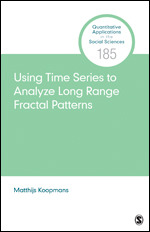Using Time Series to Analyze Long-Range Fractal Patterns
- Matthijs Koopmans - Mercy College, USA
Political Science Statistics | Quantitative Methods | Quantitative/Statistical Research (General)
Supplements
This is coherent treatment of fractal time-series methods that will be exceptionally useful.
Each analysis is explained, and also the differences between the analyses are explained in a systematic way.
This volume offers a nice introduction to the various methods that can be used to discuss long range dependencies in univariate time series data. Koopmans makes a compelling case for these methods and offers clear exposition
This amazing book provides a concise and solid foundation to the study of long-range process. In a short volume, the author successfully summarizes the theory of fractal approaches and provides many interesting and convincing examples. I highly recommend this book.



